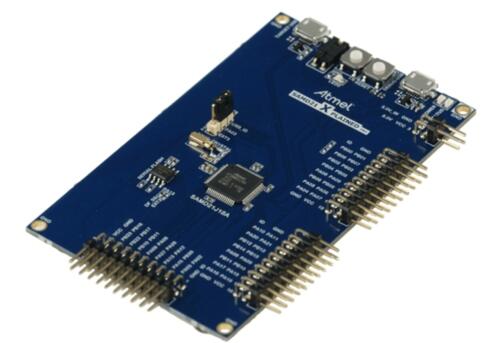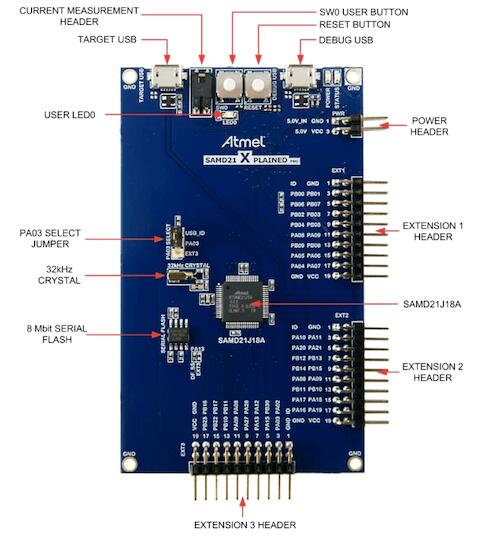SAM D21 Xplained Pro Evaluation Kit
Overview
The SAM D21 Xplained Pro evaluation kit is ideal for evaluation and prototyping with the SAM D21 Cortex®-M0+ processor-based microcontrollers. The kit includes Atmel’s Embedded Debugger (EDBG), which provides a full debug interface without the need for additional hardware.

ATSAMD21-XPRO (Credit: Microchip Technology [1])
Hardware
ATSAMD21J18 ARM Cortex-M0+ processor at 48 MHz
32.768 kHz crystal oscillator
256 KiB flash memory and 32 KiB of RAM
One yellow user LED
One mechanical user push button
One reset button
On-board USB based EDBG unit with serial console
Supported Features
The atsamd21_xpro board configuration supports the following hardware features:
Interface |
Controller |
Driver / Component |
|---|---|---|
NVIC |
on-chip |
nested vector interrupt controller |
Flash |
on-chip |
Can be used with LittleFS to store files |
SYSTICK |
on-chip |
systick |
WDT |
on-chip |
Watchdog |
ADC |
on-chip |
Analog to Digital Converter |
GPIO |
on-chip |
I/O ports |
PWM |
on-chip |
Pulse Width Modulation |
USART |
on-chip |
Serial ports |
I2C |
on-chip |
I2C ports |
SPI |
on-chip |
Serial Peripheral Interface ports |
USB |
on-chip |
Universal Serial Bus device ports |
Other hardware features are not currently supported by Zephyr.
The default configuration can be found in the Kconfig
boards/arm/atsamd21_xpro/atsamd21_xpro_defconfig.
Pin Mapping
The SAM D21 Xplained Pro evaluation kit has 3 GPIO controllers. These controllers are responsible for pin muxing, input/output, pull-up, etc.
For more details please refer to SAM D21 Family Datasheet [2] and the SAM D21 Xplained Pro Schematic [3].

Default Zephyr Peripheral Mapping:
SERCOM0 USART TX : PA10
SERCOM0 USART RX : PA11
SERCOM1 USART TX : PA16
SERCOM1 USART RX : PA19
SERCOM2 I2C SDA : PA08
SERCOM2 I2C SCL : PA09
SERCOM3 USART TX : PA22
SERCOM3 USART RX : PA23
SERCOM5 SPI MISO : PB16
SERCOM5 SPI MOSI : PB22
SERCOM5 SPI SCK : PB23
USB DP : PA25
USB DM : PA24
GPIO SPI CS : PB17
GPIO/PWM LED0 : PB30
System Clock
The SAMD21 MCU is configured to use the 32.768 kHz external oscillator with the on-chip PLL generating the 48 MHz system clock.
Serial Port
The SAMD21 MCU has six SERCOM based USARTs with three configured as USARTs in this BSP. SERCOM3 is the default Zephyr console.
SERCOM0 9600 8n1
SERCOM1 115200 8n1
SERCOM3 115200 8n1 connected to the onboard Atmel Embedded Debugger (EDBG)
PWM
The SAMD21 MCU has 3 TCC based PWM units with up to 4 outputs each and a period
of 24 bits or 16 bits. If CONFIG_PWM_SAM0_TCC is enabled then LED0 is
driven by TCC0 instead of by GPIO.
SPI Port
The SAMD21 MCU has 6 SERCOM based SPIs. On the SAM D21 Xplained Pro, SERCOM5 is connected to an 8 megabit SPI flash.
Programming and Debugging
The SAM D21 Xplained Pro comes with a Atmel Embedded Debugger (EDBG). This provides a debug interface to the SAMD21 chip and is supported by OpenOCD.
Flashing
Build the Zephyr kernel and the
hello_worldsample application:west build -b atsamd21_xpro samples/hello_world
Connect the SAM D21 Xplained Pro to your host computer using the USB debug port.
Run your favorite terminal program to listen for output. Under Linux the terminal should be
/dev/ttyACM0. For example:$ minicom -D /dev/ttyACM0 -o
The -o option tells minicom not to send the modem initialization string. Connection should be configured as follows:
Speed: 115200
Data: 8 bits
Parity: None
Stop bits: 1
To flash an image:
west build -b atsamd21_xpro samples/hello_world west flash
You should see “Hello World! atsamd21_xpro” in your terminal.
